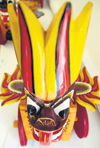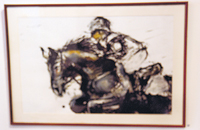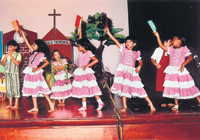|
|
||||||||||||||||||||
|
Conflict, freedom... they said their bit their way
They said what they had to say; with barbed wire, clay and paints they spoke their truths…and in their own way, they made a stand. Ranging from works on freedom of expression, to reflections on the conflict raging through the country, the artistic works on display at this exhibition were the result of a month long International Artists’ Residency. Organized by the Theertha’s International Artists Collective, the exhibition which concluded the 2006 residency began on June 28 and went on till the 30.
Held at the Harold Pieris gallery, the event featured the works of Jamil Baloch (Pakistan), Mahmudur Rahman (Bangladesh), Thisath Thoradeniya (Sri Lanka), Sanath Kalubadana (Sri Lanka), Sumedh Rajendra (India) and Rohan Amarasinghe (Sri Lanka). Professor Jagath Weerasinghe was the driving force behind the event, while Anoli Perera was the co-ordinator. For the participating artists, the residency was something of an eye opener as they had the chance to interact with people from different backgrounds and influence each other. As a result, many of the 20 odd pieces on display were experimental in nature – consisting of installations and the use of unusual materials such as barbed wire. On entering the exhibition, the first thing that caught one’s eye was Thisath’s tongue in cheek tribute to the electricity between men and women – in the shape of an adaptor and a plug point. Next Sanath’s slowly spinning ‘lampshade’ with intricately cut figures throws patterns on the screen. In the glowing light and the changing images you see those the war has claimed – they crouch, they shoot, they fall and they die – and still the lampshade spins on, and each tragedy is lived again. In the centre of the gallery, Jamil’s golden man gleams. As you walk around him, you realise he is quite literally two faced. There hangs around him an aura of untrustworthiness, for even though one face smiles benignly, and the other ingratiatingly, both faces are masks. The piece created with fibreglass, clay and real fabrics, is immediately intriguing.
A series of paintings by Mahmudur in mixed media line the walls. By their side, explicit directions on how to load a gun and shoot are printed and attached. The figures themselves are a tangle of helpless, puppet like limbs, with the torso’s perforated by numerous bullet wounds. Faceless, nameless, almost without any solid being, these images hang – they are any man. Courtesy the same artist, a strange ‘peace march’ lines up on yet another side of the gallery. Terrifying demon faces crown sturdy boxes that come attached to coconut scrapers. Occupying an entire wall, Sumedh’s art work stands out in stark relief against its white background. Depicting a large pipe carrying away the waste and pollution created by a storybook house, the piece demands honest introspection in the viewer. Rohan’s work is distributed throughout the gallery – hung from the ceiling, overflowing out of niches and framed on the wall. Barbed wire, twisted into concentric circles, is used to make a statement about the boundaries and limitations that encircle our freedom – seeming to advise restraint backed by the threat of pain and suffering. The International Artists’ Residency was a part of Theertha’s international art exchange programme. Several such residencies are held each year and their primary focus is to bring together both local and international artists. Provided with a creative environment, these men and women from diverse geographical and cultural backgrounds set out to explore the depths and breadths of their art. Crucial to the process is the exchange of artistic knowledge, skill and experience, along with shared experimentation and dialogue. The principal sponsor for this year’s International Artists’ Residency was the Ford Foundation.
Creativity and awareness Paintings and a range of items from jute rugs to dish towels, gift tags to greeting cards, pot holders to wood work articles and bread baskets will be on display at ‘Expression 2006’, a one-day exhibition of arts and crafts to be held by the Colombo Centre at the Lionel Wendt Art Gallery on July 12 from 9.15 a.m. to 7 p.m. The Colombo Centre is a place for the rehabilitation and care of young men who are mentally disadvantaged. Those currently enrolled in this centre have Down Syndrome, Autism, Cerebral Palsy or have suffered head injuries which have retarded their mental growth. A non-profit making organization, the centre uses all funds collected through voluntary donations from individuals, for its activities. The centre has its own respite facility and the students can stay overnight for a nominal rate. The centre, at present, is also in the process of looking at the long term needs such as permanent hostel facilities of these young persons, when those who now care for them may be unable to do so. The Chief Guest will be renowned artist Prof. Nalini Jayasuriya and the exhibition is taken as an opportunity not only to display the range of talents of those at the centre but also to create awareness and respect for individuals with similar needs in our society.
With Bach & jazz Cantando Cello Ensemble returns The Cantando Cello Ensemble which delighted the audience at its premier concert last year makes a welcome appearance at the Lionel Wendt Theatre on July 11, at its second public concert. The ensemble, directed by Dushy Perera includes ten cellists – Dushy Perera, Rashika Perera, Tamara Holsinger, Amila Abeysekera, Namali Fernando, Kamani Perera, Oshan Gunawardana, Joy Butscher, Sasini Chandrasinghe and Savini Chandrasinghe; all of whom are members of the Symphony Orchestra of Sri Lanka. The concert programme which covers a wide range of styles and periods, commences with Bach’s serenely beautiful “Air on a G String” and ends with “Tonight” from Bernstein’s “West Side Story”. In between many a varied delight such as Dvorak’s “Slavonic Dances” and “Vocalise” by Rachmaninov will be performed. “Bachianas Brasileiras No. 5” for soprano and an orchestra of Celli by Villa – Lobos, receives its Sri Lankan premiere at this concert, and will feature Menaka de Fonseka Sahabandu as soprano. Another piece of unusual interest will be “Gallop” by the jazz composer Bolling, performed by Kamani Perera (cello), Dushy Perera (bass), Christopher Prins (drums) and Soundarie David (piano). The guest spot on the programme will feature Ramya de Livera Perera on the piano..
Wall of many styles
A group of students of well-known artist and designer Anoma Wijewardene held a private art exhibition at the American Ambassador’s residence on Horton Place last month.
The eight artists who exhibited their work in addition to being from very different backgrounds displayed tremendous diversity in style, medium and theme. Works in pastels, pulp paintings, pen and ink, watercolours, mixed media, ‘inks, acrylics and bleach’, oils and photography lined the walls of ‘Jefferson House’. The featured artists were Prameesha Abeysekera, Marina Cayssials, Chloe de Soysa, Delini Raheem, Manisha Ranasinha, Pamela Schmoll, Deborah Sharpe-Lunstead and Hema Udeshi.
4 to 14, it’s your chance to hit the stage Lanka Children’s and Youth Theatre Organisation (LCYTO) begins its next session of “Creative Activities for Children” programme in July. The programme is conducted by Somalatha Subasinghe, the veteran playwright and theatre director and Dr. Chandana Aluthge, one of her senior theatre students. Presently the leading institution for children’s and youth theatre productions LCYTO has produced a repertoire of mainly musical theatre for children and youth and mainstream art theatre productions. Children from ages four to fourteen can take part in the programme. The programme is conducted on Saturdays from 9.30 a.m. to 1.30 p.m. For details send in a stamped envelope to the Coordinator, Lanka Children’s and Youth Theatre Organisation, No. 166/1, Buddhist Institute Avenue, Parliament Road, Kotte 10100.
Bubbling with enthusiasm, they recited, sang and danced For one and a half hours, around 180 children, between the ages of 5 and 7, acted, sang and danced, in a musical comedy, based on the story of ‘Dick Whittington’.
While one does not expect sterling performances, from children this young, these children performed exceptionally well. Whether they had lines to say, or they had to sing or dance, each and every child did so, in character. The main roles of Dick, Alice, Mr. Fitzwarren, Jack and Lisa, were rotated between three different groups of actors. This not only ensured that a child did not have to be burdened with too many lines, but it also gave more children the opportunity to act in the major roles. The child who played Toodles sustained her part very well, throughout the play. The children delivered their lines with clarity, good diction and cute expressions. The play was well scripted and moved at a good pace. From time to time, the narrators gave the main details of the story and described the passing of time, such as when Dick makes the journey from the village to London, and from London to Morocco. The dialogue was concise and uncomplicated, while the punch lines were funny without being hackneyed. And, the actors pulled off the fight scenes convincingly. It was good to see the children move quite freely, making good use of the stage, without feeling inhibited or awed by the lights and audience. In fact, I caught some of them checking to make sure that they stood under the hanging microphones, so that they would be heard better! They acted confidently and played off each other very well. When it came to the songs, which were interspersed throughout the play, we were treated to some well-known nursery rhymes and some not-so-commonly heard of songs. Each song was either dramatised or choreographed with simple yet tasteful dance sequences. The only drawback was, I felt, that the soundtracks played, were too loud and drowned the children’s’ singing. The sets were minimal but fitting for a children’s production. Likewise, all the costumes were well thought of in terms of design and colour schemes. Overall, the production boasted of stagecraft that was impressive without being overly sophisticated. Unlike other children’s productions which I have watched, ‘Dick Whittington’, from start to finish, held my attention. I think I enjoyed the play so much, because the children enjoyed themselves so much. This in the end is what is important and what the children will take away from the production.
A very convincing performance by a group of budding, cute and committed thespians! |
||||||||||||||||||||
Copyright © 2006 Wijeya Newspapers
Ltd. All rights reserved. |




